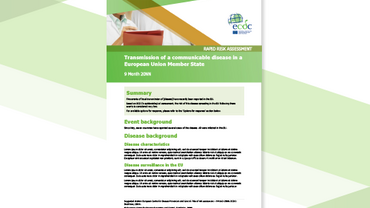Rapid Risk Assessment: Outbreak of Ebola virus disease in West Africa - third update, 1 August 2014
Following an increase in the number of cases of ebola virus disease being recorded in West Africa, ECDC has updated its risk assessment and presents options for prevention and control of the disease for European citizens.
Executive Summary
An outbreak of Ebola virus disease (EVD), which started in December 2013, continues to evolve in Guinea, Liberia and Sierra Leone. The first cases were reported from Guéckédou prefecture, a forested region of south-eastern Guinea near the border with Liberia and Sierra Leone. After a slowdown in April, the outbreak has accelerated during the last two months. This is the largest EVD outbreak ever reported, both in terms of number of cases and geographical spread.
Following an upsurge in the number of cases of Ebola Virus Disease (EVD) in Guinea, Liberia and Sierra Leone in the last weeks, ECDC evaluates the risk of importation of the disease to the EU, the risk of spreading, as well as the risk to EU travellers and residents in the affected areas in West Africa.
Overall, the risk of becoming infected remains very low if basic precautions are strictly followed as transmission of EVD requires direct contact with blood, secretions, organs or other bodily fluids of dead or living infected persons or animals. Unlike influenza, the virus is not transmitted by air or droplets.
Risk of onward transmission in the EU very low
While people infected with EVD may travel to EU from the affected countries, the risk of secondary transmission to direct close contacts (family or relatives) or in healthcare settings is still considered very low, if prevention measures are implemented, concludes the risk assessment. Such prevention measures can include information and sensitisation of returning travellers and healthcare providers.
Very low infection risk for tourists or residents in affected areas
For tourists, visitors or residents in affected areas, the risk of infection is considered very low if elementary precautions are followed: avoiding contact with symptomatic patients or dead bodies and their bodily fluids, as well as avoiding unprotected sexual contact with a patient that has recently recovered from the disease.
The highest risk for EU residents and visitors in the affected countries is within the health care system: the risk of exposure in healthcare facilities is related to the implementation of effective measures for infection transmission control. The risk assessment suggests the following preventive measures: for prevention of infection while travelling and residing in the affected areas, prevention in healthcare facilities, prevention of importation of cases to EU and prevention of spread of the disease in the EU.
The outbreak in Guinea, Liberia and Sierra Leone is the largest EVD outbreak ever reported, both in terms of cases and the geographical spread, it is also the first time EVD has spread to large cities.





